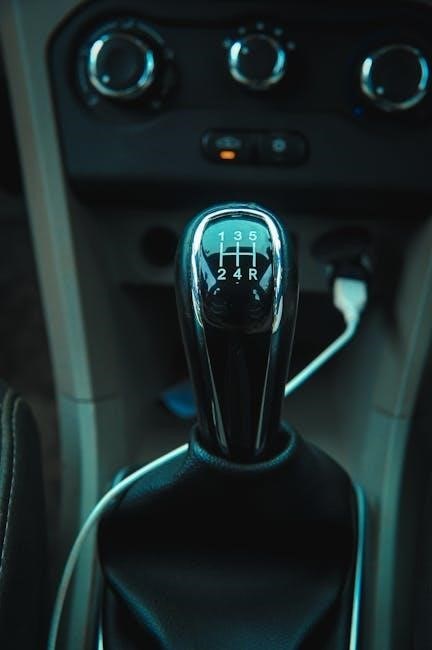The Chicco KeyFit 30 is a popular rear-facing infant car seat designed for newborns up to 30 pounds. It’s known for its ease of use and safety features, making it a trusted choice for parents.
1.1 Overview of the KeyFit 30 Infant Car Seat
The Chicco KeyFit 30 is a rear-facing infant car seat designed for newborns up to 30 pounds and 30 inches tall. It features a lightweight design, easy installation, and a newborn positioner for added comfort. The seat includes safety features like the SuperCinch LATCH and bubble-level indicators for proper leveling. It is compatible only with KeyFit 30 bases and should not be used with Fit2 bases. The manual emphasizes safety guidelines, such as avoiding front airbag positions and monitoring the child while in the seat. It also provides instructions for premature infants and suffocation risks.
1.2 Importance of Reading the Manual
Reading the Chicco KeyFit 30 manual is crucial for ensuring proper installation, usage, and safety. The manual provides detailed instructions for securing the seat, adjusting the harness, and positioning the newborn insert. It also outlines critical safety guidelines, such as avoiding front airbag positions and monitoring the child to prevent suffocation risks. Failure to follow the manual can lead to incorrect installation, compromising the child’s safety. The manual is available online and should be consulted before using the car seat to ensure compliance with all safety standards and recommendations.
Key Features and Benefits of the KeyFit 30
The KeyFit 30 offers a rear-facing design, weight capacity up to 30 pounds, and height limits up to 30 inches. It features bubble-level indicators for proper installation and includes a newborn insert for smaller infants, ensuring a secure and comfortable fit. The seat is designed for ease of use and compatibility with Chicco bases, making it a versatile and safe choice for newborns and growing babies.
2.1 Weight and Height Limits
The Chicco KeyFit 30 is designed for infants weighing 4 to 30 pounds and up to 30 inches tall. The newborn positioner is recommended for babies between 4 and 11 pounds, ensuring proper fit. For premature infants, consult the child’s doctor before use. The seat’s height limit requires the child’s head to be no less than 1.34 inches below the top of the headrest. Always adhere to these limits to ensure safety and proper positioning. These guidelines help maximize protection and comfort for your baby during travel.
2.2 Safety Features and Certifications
The Chicco KeyFit 30 boasts a robust safety profile with features like a rigid shell and energy-absorbing foam. It meets or exceeds Federal Motor Vehicle Safety Standards (FMVSS 213). The seat includes two bubble-level indicators for correct installation and a SuperCinch LATCH system for secure attachment. Its rear-facing design is optimized for crash protection, and it’s compatible with both LATCH and seat belt installation methods. These certifications and features ensure the KeyFit 30 provides reliable safety for infants, offering peace of mind for parents.
2.3 Ease of Installation and Use
The Chicco KeyFit 30 is designed for straightforward installation and use. It features the SuperCinch LATCH system, which simplifies securing the seat with a tight, even fit. The seat includes two bubble-level indicators to ensure proper leveling during installation. Additionally, the carrier can be easily clicked into and out of the base, making transitions between car and stroller seamless. The manual provides clear, step-by-step instructions, while the compact design allows for easy handling and storage. These features make the KeyFit 30 user-friendly, even for first-time parents.
2.4 Compatibility with Other Chicco Products
The Chicco KeyFit 30 is designed to integrate seamlessly with other Chicco products, enhancing its versatility. It is compatible with select Chicco strollers when using the appropriate adapters, creating a convenient travel system. Additionally, the KeyFit 30 base is specifically engineered to work with the KeyFit 30 infant carrier, ensuring a secure and proper fit. For optimal compatibility, it is essential to use only KeyFit 30 bases with the KeyFit 30 carrier, as mixing with other models like the Fit 2 may compromise safety and functionality. This compatibility ensures a smooth transition for parents using multiple Chicco products.

Installing the KeyFit 30 Without the Base
Install the KeyFit 30 without the base using your vehicle’s seatbelt. Route the belt through the seat’s designated path, ensuring a snug and secure fit. Always refer to the manual for proper guidance.
3.1 Preparing Your Vehicle
Before installing the KeyFit 30 without the base, ensure your vehicle is prepared. Clear the backseat of any loose items and adjust the vehicle seat to a comfortable position. Consult your vehicle’s manual to locate seatbelt anchors and understand any specific requirements. Ensure the seat is positioned upright and flat, with no obstructions. Refer to the Chicco KeyFit 30 manual for guidelines on vehicle compatibility and proper preparation. Always check for front airbag placement and follow safety precautions to ensure a secure installation.
3.2 Using the Seat Belt to Secure the Car Seat
To secure the KeyFit 30 without the base, route the vehicle’s seat belt through the designated paths on the car seat. Tighten the belt firmly by pulling the shoulder strap, ensuring no slack remains. Use the SuperCinch force-multiplying seat belt tightener for a snug fit. Always refer to the Chicco KeyFit 30 manual for specific guidance on seat belt routing and tightening. Properly securing the car seat ensures your baby’s safety during travel. If unsure, consult your vehicle’s manual for additional instructions.
3.3 Ensuring Proper Leveling
Proper leveling is critical for the KeyFit 30’s safety and performance. Use the built-in bubble-level indicators on either side of the car seat to ensure it’s installed at the correct angle. Adjust the seat by tilting it forward or backward until the bubbles are centered. If needed, use a pool noodle or rolled towel under the seat to achieve the proper level. Always verify leveling after installation, as improper alignment can compromise safety. Refer to the Chicco KeyFit 30 manual for detailed guidance on achieving the correct position in your vehicle.

Using the KeyFit 30 with the Base
The KeyFit 30 base offers a secure and convenient installation method. Attach the base to your vehicle using the seat belt or LATCH system, then click the car seat into place. Ensure proper alignment and tightness for safety. Always refer to the manual for specific instructions on base installation and securing the infant car seat correctly.
4.1 Installing the Base in Your Vehicle
Before installing the KeyFit 30 base, ensure your vehicle seat is clear of obstructions. Use the LATCH connectors or vehicle seat belt to secure the base, following the manual’s step-by-step guide. Tighten the base firmly to ensure no movement. Use the bubble level indicators to confirm proper alignment and leveling. Once installed, test the base by tugging gently to ensure it’s secure. The base is compatible with both KeyFit 30 and KeyFit 35 infant carriers but not with Fit2 models. Always double-check the manual for specific vehicle compatibility and installation tips.
4.2 Securing the Infant Car Seat to the Base
To secure the KeyFit 30 infant car seat to the base, align the seat’s connectors with the base’s attachment points. Gently lower the seat onto the base until it clicks into place. Ensure the seat is snug and even, using the bubble level indicators for proper alignment. Tighten the base’s straps or LATCH connectors to prevent any movement. Always verify that the seat is securely locked by gently tugging on it. Never leave the seat loosely attached, as this could compromise safety. Follow the manual’s specific instructions for a proper and safe connection.
4.3 Base vs. No Base: Pros and Cons
Using the KeyFit 30 with the base offers stability and proper leveling, ensuring a secure fit in your vehicle. The base allows for easy installation and removal of the seat, while the LATCH system provides a snug connection. However, the base adds bulk and may not fit all vehicles; Without the base, the seat is more portable but requires careful seat belt installation, which can be less convenient. Always follow the manual for proper use, as the KeyFit 30 is only compatible with its specific base, ensuring optimal safety and performance for your child.

Adjusting the Car Seat for Proper Fit
Proper adjustment ensures your child’s safety and comfort. The harness, newborn insert, and seat positioning must be correctly aligned to provide optimal support and protection during travel.
5.1 Adjusting the Harness
Adjusting the harness ensures your baby’s safety and comfort; Always ensure the harness is snug, passing the pinch test. The straps should be at or below your baby’s shoulders when rear-facing. To adjust, loosen the harness straps, then pull the chest clip to armpit level. Tighten the straps until snug, ensuring no slack. Avoid twisting the straps. As your baby grows, adjust the height by moving the harness position. Refer to the manual for specific guidance on proper adjustment to ensure optimal protection and comfort during travel.
5.2 Positioning the Newborn Insert
The newborn insert is designed for infants weighing 4–11 pounds, providing extra support and comfort. Place the insert snugly around your baby, ensuring their head and body are properly aligned. The insert should fit securely within the car seat, with no gaps. Always follow the manual’s guidance for correct placement. Remove the insert once your baby outgrows it, typically when they reach 11 pounds. For premature infants, consult your doctor before use. Proper positioning ensures safety and comfort, so double-check the fit before each use.
5.3 Ensuring the Seat is Correctly Positioned
Proper positioning of the KeyFit 30 is crucial for your baby’s safety. Use the bubble-level indicators on the base to ensure the seat is installed at the correct angle. The seat should be rear-facing and level when in use. After securing your baby, check that the harness is snug and the chest clip is at armpit level. Always verify that the car seat is tightly installed in your vehicle, with no excessive movement. For added accuracy, refer to the manual or consult a certified technician if unsure. Correct positioning ensures optimal protection and comfort for your child.

Safety Guidelines and Warnings
Never place the KeyFit 30 in a front airbag position, as it can be fatal. Avoid using the seat with incompatible bases or in overheated vehicles, risking suffocation. Always follow manual guidelines to ensure your child’s safety while in the car seat.
6.1 Never Using the Seat in a Front Airbag Position
Never place the Chicco KeyFit 30 in a vehicle position with an active front airbag. This is a critical safety precaution, as the airbag’s force during deployment can cause fatal injury to an infant in a rear-facing car seat. Always install the KeyFit 30 in a rear-facing position in the back seat, away from any front airbags. Refer to your vehicle’s manual to identify airbag positions and ensure compliance with all safety guidelines. This warning is non-negotiable to protect your child’s life in the event of a collision.
6.2 Avoiding Overheating and Suffocation Risks
Prevent overheating by avoiding bulky clothing or blankets inside the KeyFit 30, as they can trap heat and pose suffocation risks. Ensure the car seat fabric is breathable and free from loose materials. Never leave the infant unattended in the car seat, especially in warm environments. If the baby falls asleep, move them to a safe, flat surface like a crib to reduce suffocation hazards. Always follow manual guidelines to maintain a safe and comfortable environment for your child while using the KeyFit 30.
6.3 Monitoring the Child While in the Seat
Always monitor your child while they are in the KeyFit 30 to ensure their safety and comfort. Regularly check the harness fit and positioning to prevent slouching or shifting. Ensure the child’s airway remains clear and that the seat is properly ventilated to avoid overheating. Avoid leaving the child unattended in the car seat, especially in warm environments, as this can lead to discomfort or potential risks. Never allow the child to sleep in the car seat for extended periods outside of the vehicle. Follow the manual’s guidelines for safe and attentive monitoring.

Maintenance and Cleaning
Regularly clean the KeyFit 30 using mild soap and water for fabric and harness. Inspect for damage and follow manual guidelines for replacement to ensure safety.
7.1 Cleaning the Car Seat Fabric
To clean the KeyFit 30 fabric, remove it and use mild soap and water. Gently scrub stains with a soft cloth, rinse thoroughly, and air dry to prevent damage. Avoid harsh chemicals and dryers. Clean the harness and plastic parts with a damp cloth, ensuring no electrical components are compromised. Always follow the manual’s guidelines for approved cleaners to maintain safety and warranty. Inspect for wear or damage during cleaning and replace parts as needed. Proper cleaning ensures the seat remains safe, comfortable, and functional for your baby.
7.2 Inspecting the Seat for Damage
Regularly inspect the KeyFit 30 for damage to ensure safety. Check the harness, buckle, and fabric for frays or wear. Look for cracks in the plastic shell or base. Inspect the level indicators and attachment points for proper function. Avoid using harsh chemicals, as they may damage materials. If any damage is found, discontinue use and consult the manual or contact Chicco for replacement parts. Proper inspection ensures the seat remains safe and reliable for your child’s protection.
7.3 When to Replace the Car Seat
The KeyFit 30 car seat should be replaced if it exceeds its expiration date, usually 6-7 years from manufacture. Replace it immediately after any accident, even if no visible damage occurs. If the seat shows signs of wear, such as cracks, frays, or faded labels, it must be replaced. Additionally, replace the seat when your child outgrows it, reaching the weight (30 lbs) or height limits. Always follow the manual’s guidelines to ensure your child’s safety and the seat’s effectiveness.

Troubleshooting Common Issues
Troubleshooting the KeyFit 30 involves addressing common issues like harness tightness, leveling problems, or base installation difficulties. Always refer to the manual for solutions or contact Chicco support for assistance.
8.1 The Harness Feels Too Tight
If the harness feels too tight, ensure it is snug but allows two fingers to fit flat against the chest. Adjust the straps by loosening or repositioning the baby. Consult the manual for proper fit guidance to avoid discomfort or safety risks. Regular checks ensure the harness remains correctly adjusted as the baby grows.
8.2 The Seat Won’t Level Properly
If the KeyFit 30 won’t level properly, check the base or seat for correct positioning. Use the built-in bubble levels to ensure accuracy. Adjust the base or seat as needed, and verify your vehicle’s seat is even. If issues persist, consult the manual for troubleshooting steps or contact Chicco support for assistance. Proper leveling is crucial for safety and proper function of the car seat.
8.3 The Base Won’t Click Into Place
If the KeyFit 30 base doesn’t click into place, ensure the base is properly aligned with the car seat. Check for any obstructions or debris that may prevent a secure connection. Verify that the base is correctly installed in the vehicle and that the seat belt or LATCH system is tightly secured. If the issue persists, refer to the manual for troubleshooting steps or reset the base by removing and reinstalling it. Proper engagement is essential for safety and function.

Accessories Compatible with the KeyFit 30
Chicco KeyFit 30 supports various accessories, including newborn positioner inserts, canopies, and travel bags, enhancing comfort, convenience, and storage for parents on the go.
9.1 Newborn Positioner Insert
The Chicco KeyFit 30 Newborn Positioner Insert is designed for infants weighing 4–11 pounds, providing extra support and comfort. It ensures proper head and neck alignment, promoting safety and relaxation during travel. The insert is lightweight and breathable, preventing overheating. It is specifically tailored for smaller infants, helping to maintain a snug and secure fit within the car seat. For premature babies, consulting the infant’s doctor before use is recommended. This accessory enhances the overall safety and comfort of the KeyFit 30, making it ideal for newborns.
9.2 Canopy and Sunshade
The Chicco KeyFit 30 features a detachable canopy designed to protect your baby from sunlight and weather conditions. The canopy is easy to remove and reattach, offering flexibility for various situations. It also includes a sunshade that provides additional shade, ensuring your infant’s comfort during travel. Both the canopy and sunshade are made from breathable materials to promote airflow and regulate temperature. This accessory enhances the overall convenience and comfort of the KeyFit 30, making it an essential component for outdoor trips and sunny days.
9.3 Travel Bags and Storage Options
Chicco offers travel bags specifically designed for the KeyFit 30, providing a convenient and protective way to transport the car seat. These bags are durable, with padded interiors to safeguard the seat during travel. For storage, the car seat should be kept in a dry, cool place away from direct sunlight to prevent damage. The manual also recommends cleaning the seat before storage to maintain hygiene and ensure it remains in good condition for future use.

Comparison with Other Models
The KeyFit 30 is often compared to the KeyFit 35 and Fit2, with differences in weight limits and base compatibility, ensuring it remains a top choice for safety and ease of use.
10.1 KeyFit 30 vs. KeyFit 35
The KeyFit 30 and KeyFit 35 share many similarities, but the KeyFit 35 offers a higher weight limit of up to 35 pounds, extending its usability. Both models use the same base, ensuring compatibility, but the KeyFit 35 provides more flexibility for larger infants. While the KeyFit 30 is ideal for smaller babies, the KeyFit 35 is preferred for its longer-lasting use, making it a better option for parents expecting heavier babies or wanting a car seat that grows with their child.
10.2 KeyFit 30 vs. Fit2
The KeyFit 30 and Fit2 are both popular infant car seats from Chicco, but they cater to different needs. The KeyFit 30 is designed for infants up to 30 pounds, while the Fit2 offers extended use with a higher weight limit and additional features like a longer shell for growing babies. Unlike the KeyFit 30, the Fit2 cannot be used with the KeyFit 30 base, emphasizing the importance of compatibility when choosing between these models for your child’s safety and comfort.
10.3 KeyFit 30 vs. Other Infant Car Seats
The KeyFit 30 stands out among other infant car seats for its ease of installation and compatibility with Chicco strollers. Unlike some competitors, it offers a secure fit for smaller newborns with its newborn positioner. While other seats may have higher weight limits, the KeyFit 30 excels in simplicity and portability. Its bubble-level indicators and one-pull harness ensure proper positioning, making it a top choice for safety-conscious parents. Compared to brands like Britax or Graco, the KeyFit 30 balances affordability with premium features, making it a reliable option for many families.

Where to Find the Manual and Additional Resources
The Chicco KeyFit 30 manual is available on Chicco’s official website, ManualsLib, and other online resources. Video tutorials and guides provide additional support for installation and usage.
11.1 Downloading the Manual from Chicco’s Website
To download the Chicco KeyFit 30 manual, visit the official Chicco website and navigate to the support or resources section. Search for the KeyFit 30 model, and select the appropriate PDF manual; Ensure the manual is for the correct product by verifying the model number. Additional resources, such as video tutorials and troubleshooting guides, are also available on the site. For further assistance, refer to ManualsLib or Chicco’s customer support. Always ensure you’re using the correct manual for your specific KeyFit 30 model to guarantee accurate information.
11.2 ManualsLib and Other Online Resources
ManualsLib offers free access to the Chicco KeyFit 30 manual, allowing users to download or view the PDF online. This platform provides a convenient alternative to Chicco’s official website. Additionally, other online resources include video tutorials and FAQs that address common installation and usage questions. ManualsLib has a comprehensive library of Chicco car seat manuals, including the KeyFit 30, rated 9.4 by users. Ensure compatibility by verifying the model number before downloading. These resources help parents ensure proper installation and safe use of the KeyFit 30 infant car seat.
11.3 Video Tutorials and Installation Guides
Video tutorials and installation guides for the Chicco KeyFit 30 are widely available online, offering step-by-step instructions for proper use. Platforms like YouTube and Chicco’s official website provide detailed guides, covering topics such as base installation, seat belt usage, and leveling. These resources are particularly helpful for visual learners and first-time parents. The manual emphasizes the importance of following these guides to ensure safety and correct installation. Tutorials also highlight key features like bubble-level indicators and the SuperCinch system, making the process easier and more efficient for users.
The Chicco KeyFit 30 is a top-rated infant car seat praised for its safety, ease of use, and innovative features, making it a trusted choice for parents and experts alike.
12.1 Final Thoughts on the KeyFit 30
The Chicco KeyFit 30 stands out as a reliable and safe infant car seat, offering ease of installation and use. Its compatibility with Chicco strollers and bases adds convenience. The seat’s newborn positioner and weight limits (4-30 lbs) ensure a snug fit for preemies and growing infants. Parents appreciate its clear manual and durable design. While it lacks some advanced features of newer models, its proven track record and user-friendly design make it a top choice for safety-conscious families. It’s a worthwhile investment for protecting little ones on the go.
12.2 Encouragement to Follow Manual Guidelines
Adhering to the Chicco KeyFit 30 manual is crucial for ensuring your child’s safety and optimal use of the car seat. The manual provides detailed instructions for installation, harness adjustment, and proper positioning, all of which are essential for protecting your infant. Always follow the guidelines for weight and height limits, and avoid using incompatible bases or accessories. By adhering to the manual, you can prevent potential risks and ensure your child travels safely. Regularly reviewing the manual will help you stay informed and confident in your ability to use the KeyFit 30 correctly.

